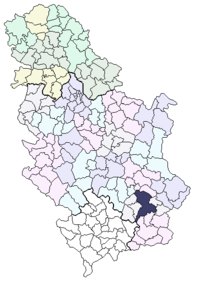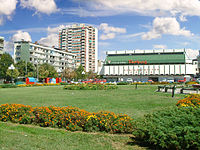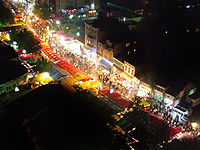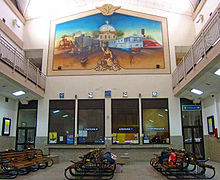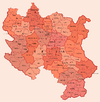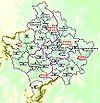- Leskovac
-
Leskovac
Лесковац— City — Panoramic view of Leskovac from the Hisar Hills 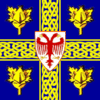
FlagLocation of the municipality of Leskovac within Serbia Coordinates: 43°00′N 21°57′E / 43°N 21.95°E Country Serbia District Jablanica Settlements 144 Government – Mayor Slobodan Kocic (DS) Area[1] – Municipality 1,025 km2 (395.8 sq mi) Population (2011 census)[2] – Town 59,610 – Municipality 143,962 Time zone CET (UTC+1) – Summer (DST) CEST (UTC+2) Postal code 16000 Area code +381 16 Car plates LE Website www.cityofleskovac.org Leskovac (Serbian Cyrillic: Лесковац, pronounced [lě̞skɔ̝v̞at͡s]) is a city and municipality in southern Serbia. It is the administrative center of the Jablanica District of Serbia. According to the 2011 census, the city has 59,610 inhabitants, while the municipality has 143,962.
Contents
History
Traces of life of the Brnjica culture (8th century BC) is seen at the Hisar Hill that was protected by a deep moat with a palisade on its inner side, a fortification similar to that of another fortification on the Gradac site in Lanište in the Velika Morava basin.[3][4] A later Iron Age settlement existed at Hisar dating from the 6th century BC until the 4th century BC.[4] Besides Greek fibulae and pottery, Triballi (Thracian) tombs have been excavated in 2005.[5] Archeological findings from the multi-layer sites indicate that the Scordisci and Triballi inhabited the Leskovac valley before the Roman conquest in the 1st century BC.[4] Famous cultural-historic monuments in this area are: the Roman necropolis in Mala Kopasnica originating from 2nd century AD, the Eastern Roman town of Justiniana Prima built in 535 AD. Slavs settled the region in the 6th century, and the town was known as Dubočica.
The Battle of Dubočica took place on September 24, 1454, between the Serbian Despotate and the invading Ottoman Empire, and ended in a Serbian victory. During Ottoman rule Leskovac was part of the Sanjak of Niš.[6]
The Jasunje monasteries dedicated to the Virgin of Transfiguration and St. John the Baptist were built in 1499 as an endowment of sister Ksenija. The Church of St. John the Baptist was built in the 16th century.
Leskovac became part of Serbia after the Treaty of Berlin, at which time Serbia also became fully independent from the Ottoman Empire. Full independence from the Ottoman Balkans initially had a negative impact on trade. However, by the end of the 19th century, the town of Leskovac was famous across the Balkans for its workshops which turned hemp into rope. Leskovac was known as Leskofça during Ottoman rule and was bounded to Niş sanjak until 1878.
Soon there were three watermill-driven lace producers in the region. In 1896, the founders of these companies pooled their resources and bought factory equipment for the production of woollen cloth from the German Empire. This was the first factory on the outskirts of the town. In 1903, a factory for hemp processing was built on the riverbank north of the old town centre. Amidst the First Serbian Uprising of the Serbian revolution (1804–1815), a forbidden Serbian Orthodox church was built in the town, through tricking the Turkish lords that the building would instead serve as a residence for the town-priest, and added a chimney, hence its name Odžaklija (Chimney). In 1922, the Teokarevic family opened a wool cloth factory in the small town of Vucje near Leskovac. By 1938, the private textile factories of Leskovac town employed 2,560 workers In the 1870s, there were thousands of hemp-processors in Leskovac, producing up to 150,000 cartloads per year.
The city was once known as "Little Manchester", because of its 19th-century textile industry which was second only to that of Manchester, England. The city continued to be a major textile center until the collapse of communism in Eastern Europe, but due to the economic isolation of Serbia resulting from ethnic wars, its remote location, and failure to privatize the mills, the industry collapsed resulting in depression of the economy in the area.[7]
World War II
During World War II, the city was part of Nedić's Serbia. It was heavily bombed by the Allies in 1944, with estimates of civilian casualties varying from over a thousand to six thousand.[8][9] The heaviest bombing occurred on September 6, 1944 when most of the central part of the town was destroyed.[10] The date is marked annually in the city.
Fitzroy Maclean the head of the British military mission to the Partisans wrote ..... as we watched the whole of Leskovac seemed to rise bodily in the air in a tornado of dust and smoke and debris, and a great rending noise fell on our ears. ..... What was left of Leskovac lay enveloped in a pall of smoke; several buildings seemed to be burning fiercely. Even the Partisans seemed subdued. This was part of Operation Ratweek to attack the enemy withdrawal, and air reconnaissance had confirmed the presence of a strong concentration of armour and motor transport there, although he said the use of 50 ‘Heavies’ or Flying Fortresses did seem rather like taking a sledge-hammer to crack a walnut..[11]
Kosovo conflict
On 12 April 1999, during the NATO bombing of Yugoslavia a bridge near Leskovac (Grdelička klisura) was destroyed by a NATO aircraft as a passenger train was crossing. The act was highly condemned with the bridge being struck twice (the train itself having been bombed from the first attack).
Geography
Subdivisions
The city proper of Leskovac is divided into the following local communities (месне заједнице or mesne zajednice):
- Lamele (Ламеле)
- Radničko (Радничко)
- Dubočica (Дубочица)
- Centar (Центар)
- Morava (Морава)
- Hisar (Хисар)
- Prva južnomravska brigada (Прва јужноморавска бригада)
- Rade Žunić (Раде Жунић)
- Marko Crni (Марко Црни)
- Kosta Stamenković (Коста Стаменковић)
- Veljko Vlahović (Вељко Влаховић), named after a Serbian-Montenegrin Communist
- Milentije Popović (Милентије Поповић), named after a Serbian Communist
- Stojan Ljubić (Стојан Љубић)
- Moša Pijade (Моша Пијаде), named after a Serbian-Jewish Communist
Populated places
Municipality of Leskovac has 144 settlements (the most among Serbian municipalities), scattered over the territory of 1025 km², which is among the largest in Serbia. Apart from the city, two other settlements are classified as "urban": Grdelica, with population of around 2,400 and Vučje (3,300). Other larger villages are Bratmilovce (3,500), Vinarce (3,100), and Brestovac (Leskovac) (2,100). The full list of populated places is:
Babičko (515) • Badince (521) • Barje (372) • Belanovce (600) • Beli Potok (629) • Bistrica (79) • Bobište (1782) • Boćevica (151) • Bogojevce (1571) • Bojišina (245) • Bratmilovce (3531) • Brejanovce (364) • Brestovac (2086) • Bričevlje (241) • Brza (1211) • Bukova Glava (295) • Bunuški Čifluk (505) • Čekmin (915) • Čifluk Razgojnski (335) • Crcavac (141) • Crkovnica (133) • Crveni Breg (30) • Čukljenik (636) • Dedina Bara (802) • Dobrotin (321) • Donja Bunuša (306) • Donja Jajina (1338) • Donja Kupinovica (97) • Donja Lokošnica (1060) • Donja Slatina (300) • Donje Brijanje (1487) • Donje Krajince (764) • Donje Sinkovce (1661) • Donje Stopanje (1136) • Donje Trnjane (289) • Donji Bunibrod (644) • Draškovac (791) • Drćevac (309) • Drvodelja (245) • Dušanovo (236) • Gagince (132) • Golema Njiva (118) • Gorina (732) • Gornja Bunuša (633) • Gornja Jajina (637) • Gornja Kupinovica (189) • Gornja Lokošnica (134) • Gornja Slatina (210) • Gornje Krajince (786) • Gornje Sinkovce (454) • Gornje Stopanje (1756) • Gornje Trnjane (250) • Gornji Bunibrod (762) • Gradašnica (472) • Grajevce (404) • Graovo (277) • Grdanica (605) • Grdelica (2383) • Grdelica (1172) • Guberevac (1875) • Igrište (292) • Jarsenovo (428) • Jašunja (514) • Jelašnica (289) • Kaluđerce (206) • Karađorđevac (417) • Kaštavar (68) • Koraćevac (192) • Kovačeva Bara (167) • Kozare (362) • Krpejce (47) • Kukulovce (298) • Kumarevo (825) • Kutleš (651) • Ličin Dol (139) • Lipovica (1287) • Mala Biljanica (207) • Mala Grabovnica (275) • Mala Kopašnica (255) • Manojlovce (778) • Međa (872) • Melovo (63) • Milanovo (546) • Miroševce (1053) • Mrkovica (14) • Mrštane (1431) • Nakrivanj (1315) • Navalin (898) • Nesvrta (128) • Nomanica (317) • Novo Selo (120) • Oraovica (152) • Oraovica (2210) • Orašac (582) • Oruglica (173) • Padež (58) • Palikuća (387) • Palojce (484) • Pečenjevce (1776) • Petrovac (108) • Piskupovo (216) • Podrimce (283) • Predejane (1222) • Predejane (491) • Presečina (448) • Priboj (642) • Radonjica (903) • Rajno Polje (739) • Ravni Del (78) • Razgojna (904) • Rudare (551) • Šainovac (216) • Šarlince (854) • Šišince (639) • Slatina (639) • Slavujevce (431) • Smrdan (155) • Strojkovce (1344) • Stupnica (402) • Suševlje (228) • Svirce (436) • Todorovce (521) • Tulovo (739) • Tupalovce (380) • Turekovac (1794) • Velika Biljanica (516) • Velika Grabovnica (1452) • Velika Kopašnica (676) • Velika Sejanica (791) • Veliko Trnjane (1013) • Vilje Kolo (11) • Vina (232) • Vinarce (3090) • Vlase (584) • Vučje (3258) • Žabljane (724) • Zagužane (339) • Zalužnje (482) • Živkovo (669) • Žižavica (189) • Zloćudovo (271) • Zlokućane (217) • Zoljevo (259)
Ecology and Geology
Because it is characterized by a moderate continental climate with very mild winters and moderately warm summers, the region of Leskovac abounds in natural scenery which is exceptional in its diversity and beauty. Numerous mountains, lakes, rivers, spas, canyons and gorges are a distinction of this region.
Rivers
The largest river in the region of Leskovac is the Južna (South) Morava River, which flows South to North, and together with the Zapadna (West) Morava River forms the Velika (Great) Morava River. Tributaries of the Južna Morava are: the Vlasina river, which collects water from Lake Vlasina and flows through Crna Trava and Vlasotince; the Veternica river, which flows through Leskovac;
The Jablabica river, which springs from the foot of Goljak and flows through Medveđa and Lebane; the Pusta (Deserted) river, which starts on Radan mountain, fills Lake Brestovačko and flows through Bojnik. The river Vučjanka, which springs from the Kukavica mountain, flows through Vučje and is a tributary of the Veternica river. The river Vučjanka, which springs from the Kukavica mountain, flows through Vučje and is a tributary of the Veternica river. Also known in the Leskovac region are The Kozaračka, Predejanska, Kopašnička and Sušica rivers.
Flora and fauna
The natural resources of the Leskovac region are favorable for a great diversity of plant and animal life. The most widespread of animals are: roe deer, wild boar, hare, partridges and pheasants, while the plant world is noted for a very diverse presence of medicinal and other useful plants. The first floristic investigations in this territory were carried out by the founder of Serbian botany Josif Pancić towards the end of the 19th century.
Together with hicillaborators he found an exceptionally rare plant at Ostorzub, the endemorelict lovorvišnja, zelenoče (Prunus Laurocerasus). For over one hundred years this plant occupied the attention of botanists from all over the world, because until then, it was only found in Bulgaria, and 2-3 other localities.
Because of this Ostrozub was declared a strict natural reservation. The Leskovac region possesses more than 50 other rare (mostly medicinal) plants, oedemas etc.
Environment
Leskovac is the first city in Serbia which has a sanitary landfill. Željkovac depot spreads over 80 hectares and is made by all European standards. In the landfill there is a center for atmospheric water purification, center for the selection and disposal systems for the detection of all types of pollution. Company Por Werner and Weber for Serbia, began construction of the center for collecting and recycling waste, and is the first city in the Balkans, where starting this job.
Culture
Further information: Culture of SerbiaArchitecture
Events
Roštiljijada
Roštiljijada (Barbecue week) is a grilled meat festival that has been organized in Leskovac for many years, and takes place annually at the beginning of September. During the event, the main boulevard is closed for traffic for five days, and food stands are put up along the streets. The event brings visitors from all over Serbia as well as tourists. The organisers hold competitions, such as making the biggest burger, the Pljeskavica. The festival is the highlight of the season in Leskovac.
International Carnival
In 2009 Leskovac officially became an International Carnival city, admitted by The Association of European Carnival cities, which has over 50 members from Europe and America. The Leskovac Carnival is held in a time of Rostiljijada festival. Around 1200 people take part in the carnival, of which one third part from abroad. The City Government considers to separate this event in 2010. as a special tourist event which will be introduced as a special offer of the city.
Theater Marathon
Theater Marathon, takes place every year in November and lasts 9 days. It runs performances of National Theaters from all over Serbia. This event takes place in Nardonom Theater in Leskovac.
Leskovac International Film Festival
First International film festival was held in 2008. The idea of the film in the city is not that new. In 1996, a group of enthusiasts, with chairman Rade Jovic, organized the Festival which were shown films of domestic production. Today, many years later, Leskovac host an International Film Festival. The Festival presents awards in 3 categories: - "Golden hazelnuts" - Best Director - "Hazelnut leaf" - critics awards - "Vox populi" - Audience Award.
Transportation
Leskovac is also a traffic junction of sorts. International trains traveling from Europe to Skoplje, Thessalonica and Athens pass through this city. Nineteen trains stop in Leskovac every day. The railway came to Leskovac in 1886. Leskovac today has one of the newest and most modern railway stations in Serbia.
Bus traffic is also very well developed, bearing in mind that Leskovac has been criss-crossed with roads. The most important is the E 75 road which connects the borders of Hungary and Macedonia. Regional roads lead from Leskovac to Priština, Pirot and Bosilegrad. The distance from Leskovac to Niš is 45, to Belgrade 280, and to Sofia 155 kilometers.
Leskovac has a regional airport, which is commonly used for sporting and agricultural flights. Also in summer the airport is used for air taxi. The nearest international airport is The Constantine the Great Airport located 45 km from city center.
Demographics
Ethnic groups in the municipality (2002 census):
- Serbs = 161,925
- Bulgarians = 3,832
In 2002 the city's population was 63,185 of whom the majority are primarily Serbs (57,661). Other significant ethnic groups include Bulgarians, Macedonians, and Yugoslavs. In January 2007, there were an estimated 500 persons of Chinese origin living in Leskovac.[12]
At one time the second largest city in Serbia, today Leskovac is blighted by economic problems with many working age people migrating out of the area.[7]
Famous or notable citizens
- Nikola Skobaljić, medieval military commander
- Sima Bunić, actor, playwright, director, set designer.
- Sreten Dinić, educator, writer and publicist.
- Michael Nikolic - Sikička, a prominent merchant, district president of Leskovac, founder and head of the Trade School and president of Leskovac trademark youth
- Jacques Konfino, writer, physician and translator.
- Sergius Dimitrijevic, Doctor of Legal Sciences, historiographer, writer.
- Dragutin Đorđević, archpriest Stavrophor, ethnographer.
- Jovan Jovanović, lawyer, publicist, demographer and anthropologist.
- Milivoje Perovic, Doctor of Legal Sciences, journalist and writer.
- Dobrivoje Kapisazović, poet, storyteller, playwright and humorist.
- Dragoljub Trajkovic, lawyer, historiographer, chronicler, writer.
- Jovan Popovic, Lawyer, publicist, demographer and anthropologist.
- Zvonko Marić, an academic physicist.
- Bozidar Djordjevic - Kukar, industrialist and founder of the HFI Zdravlje - Actavis
- Borislav Zdravkovic, Poet and Theater critic.
- Tomislav N. Cvetkovic, poet, storyteller and playwright.
- Nicholas Timčenko, philosopher and literary critic.
- Miodrag Stojkovic, world famous geneticist
- Gmitar Obradović, painter (1935–2008)
- Gojko Mitic, one of the most famous actors of East Germany
- Toma Zdravkovic, singer of folk music, bohemian
- Ljubisa Stojanovic Louis, singer
- Marko Markovic, journalist and sports commentator
- Trajko Rajkovic, one of the best Yugoslav basketball players
- Bojan Dimitrijević, actor
- Sloboda Micalovic, actress
- Darko Filipović, singer
- Marija Mitrovic, singer
- Mija Kulic, satirist and artist
- Novica Zdravkovic, singer of folk music, (brother of Toma Zdravkovic)
International relations
See also: List of twin towns and sister cities in SerbiaTwin towns — Sister cities
Leskovac is twinned with:
Notes
- ^ "Municipalities of Serbia, 2006". Statistical Office of Serbia. http://webrzs.stat.gov.rs/axd/en/Zip/OG2006webE.zip. Retrieved 2010-11-28.
- ^ "2011 Census of Population, Households and Dwellings in the Republic of Serbia – FIRST RESULTS". Bulletin (Statistical Office of the Republic of Serbia) 540. 2011. ISSN 0354-3641. http://media.popis2011.stat.rs/2011/prvi_rezultati.pdf. Retrieved 2011-11-21.
- ^ Stojic 1986, 61–62. YU
- ^ a b c http://scindeks-clanci.nb.rs/data/pdf/0350-0241/2004/0350-02410454193S.pdf
- ^ http://www.b92.net/info/vesti/index.php?yyyy=2005&mm=07&dd=26&nav_id=173384
- ^ Godišnjak grada Beograda. Museum of the Belgrade. 1977. p. 116. http://books.google.com/books?id=OE_jAAAAMAAJ&q=%22%D0%9D%D0%B8%D1%88%D0%BA%D0%B8+%D1%81%D0%B0%D0%BD%D1%9F%D0%B0%D0%BA%22&dq=%22%D0%9D%D0%B8%D1%88%D0%BA%D0%B8+%D1%81%D0%B0%D0%BD%D1%9F%D0%B0%D0%BA%22&hl=en&ei=6MgaTq6QF8_2sgbnv_S4Dw&sa=X&oi=book_result&ct=result&resnum=1&ved=0CCcQ6AEwADgK. Retrieved 11 July 2011.
- ^ a b "A Serbian Region Unravels With Its Textile Industry", article by Nicholas Wood in the New York Times, January 29, 2007
- ^ History of Leskovac
- ^ Needless and thoughtless bombing
- ^ Godišnjica savezničkog bombardovanja Leskovca
- ^ Maclean, Fitzroy (1949). Eastern Approaches (pp486-7). Jonathan Cape, London.
- ^ "Discussion Paper: The cost of non-Europe. Textile towns and the future of Serbia," European Stability Initiative, January 18, 2007, at http://www.esiweb.org/index.php?lang=en&id=156&document_ID=83
See also
External links
Categories:- Populated places in Central Serbia
- Municipalities of Central Serbia
- Leskovac
Wikimedia Foundation. 2010.


